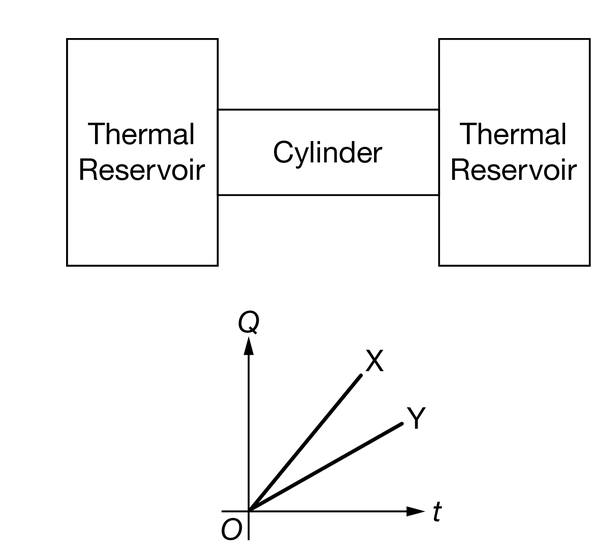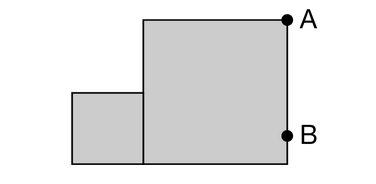Question

The figure shows an experimental setup with two thermal reservoirs connected by a uniform solid cylindrical bar. The experiment is performed twice, once with bar X and then with bar Y. The graph shows the amount of energy Q transferred through each bar as a function of time t.
If there is only one difference between the experimental situations, which of the following could account for the differences in the lines on the graph for each bar? Select two answers.
A The thermal conductivity of bar X is greater than that of bar Y .
B The area of the ends touching the reservoirs for bar X is less than that for bar Y .
C The length of bar X is less than that of bar Y .
D The difference in the temperatures of the reservoirs is less for bar X than bar Y .
▶️Answer/Explanation
Ans:A , C
The equation for thermal conductivity \(\frac{Q}{Δt}=\frac{kA ΔT}{L}\) indicates that the rate of energy transfer (which is equal to the slope of the line) is proportional to the thermal conductivity k. Since the graph for X is greater than that for Y, it may have a greater thermal conductivity.
The equation for thermal conductivity \(\frac{Q}{Δt}=\frac{kA ΔT}{L}\) indicates that the rate of energy transfer (which is equal to the slope of the line) is inversely proportional to the length L. Since the graph for X is less than that for Y, it may have a smaller length.
Question

A student has four square plates. The two large plates are the same size but made of materials with different thermal conductivity, and are initially at thermal equilibrium with their surroundings. The two identical small square plates are initially heated to a temperature greater than that of the surroundings. Each small plate is placed in contact with one of the large plates in the configuration shown. For each configuration, the student will measure the time it takes for the temperature to begin to rise at one or both of the labeled points. A shorter time means a higher thermal conductivity. Measurement at which of the points gives the best information for determining which material has higher thermal conductivity?
A Measurement at point A only, because point A is farther from the line of contact between the plates than point B .
B Measurement at point B only, because point B is closer to the line of contact between the plates than point A .
C Measurement at point A and at point B , because the average time for the two points is needed.
D Measurement at either point A or point B , because the relative times for either point will give sufficient information.
▶️Answer/Explanation
Ans:D
The time measured at either point A or point B will be less for the plate made from the material with higher thermal conductivity.
Question
Students are given a solid rod made of an unknown material and are asked to determine the thermal conductivity k of the rod. The rod is initially at room temperature. They measure the length L and the cross-sectional area A of the rod. Which of the following procedures would provide the most reliable estimate of k ?
A Submerge one end of the rod in a container of ice and water and measure how long it takes for the temperature of the other end of the rod to reach 0°C .
B Place one end of the rod in a water bath at 100°C . At regular time intervals, measure the temperature at the other end of the rod and the amount of energy needed to keep the water bath at 100°C .
C Submerge the rod in a water bath held at 100°C . At regular time intervals, measure the temperature of the water bath.
D Submerge the rod in a water bath held at 100°C . At regular time intervals, remove the rod and quickly measure the temperature at both ends of the rod.
▶️Answer/Explanation
Ans:B
The equation that relates thermal conductivity to the dimensions of the rod is \(\frac{Q}{Δt}=\frac{kA ΔT}{L}\) . The amount of energy needed to keep the water bath at 100°C is the amount of energy transferred to the rod. This procedure provides data on all the needed quantities.
Question

The table lists experimental data related to the conduction of energy by three slabs of metal. The slabs have identical dimensions but are made of different metals. Which of the following correctly ranks the metals’ thermal conductivities k ?
A \(k_3>k_2>k_1\)
B \(k_1>k_2>k_3\)
C \((k_1=k_2)>k_3\)
D \((k_1=k_3)>k_2\)
▶️Answer/Explanation
Ans:B
\( k=(\frac{ΔL}{AΔT})\frac{Q}{Δt}\) . The slabs have the same area and width. The data in the table indicate that the temperature difference is also the same for all three slabs. Thus \(k=X\frac{Q}{Δt}\), where X is a constant. Substituting values, \(k_1=X\frac{100J}{6s}\) , \(k_2=X\frac{100J}{12s}=\frac{1}{2}k_1\), and \(k_3=X\frac{50J}{12s}=\frac{1}{4}k_1\).
Question
Heat conduction through a slab of a certain material depends on all of the following EXCEPT
(A) area
(B) temperature difference between the face of the materials
(C) thickness of the material
(D) specific heat capacity of the material
▶️Answer/Explanation
Ans:(D)
Heat capacity is related to energy absorption and temperature change, not to the transfer of thermal energy (heat).
